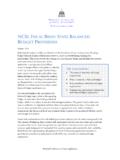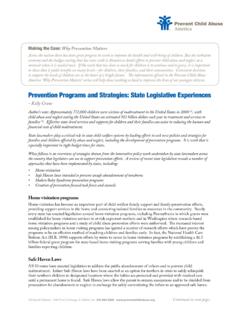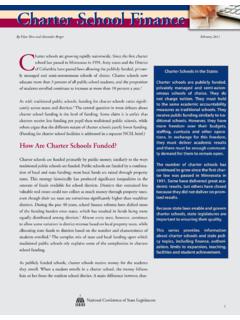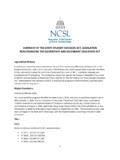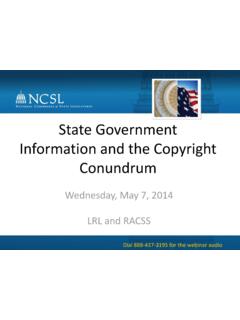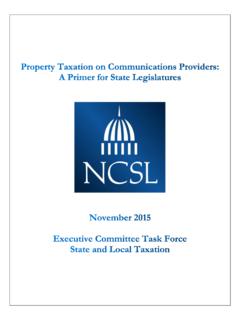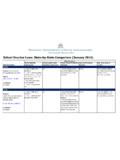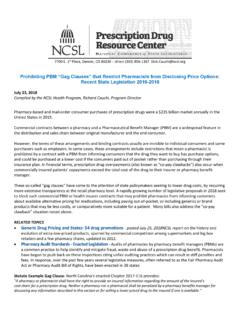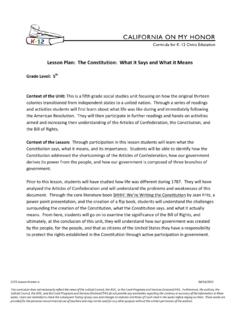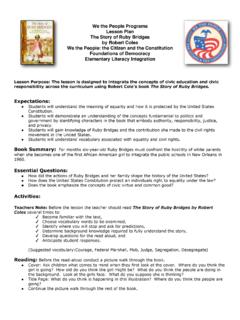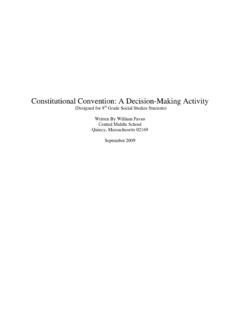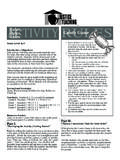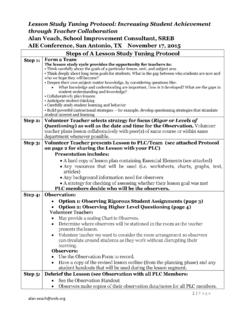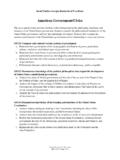Transcription of Lesson Plans for High School Civics, Government and U.S ...
1 FU N D A M E N T A L S O F RE P R E S E N T A T I V E DE M O C R A C YLesson Plans for high School civics , Government and History ClassesFundamentals of Representative DemocracyLesson Plans for high School civics , Government and History ClassesBy Alan RosenthalThese lessons about the fundamentals of representative democracy are designed mainly for civics and American Government courses taught at the high - School level. They also can be used in American history courses. The lessons relate to core themes that lie at the very center of American Government and politics, and practically every Lesson needs to be built on it.
2 They are adapted to state standards for civics and by the Department of Education under the Educating for Democracy Act approved by the CongressJuly 2009 Printed on recycled paper. 2009 by the National Conference of State Legislatures. Permission granted to reproduce materials needed for classroom use of the Lesson 1-978-58024-559-3Ce n t e r f o r Ci v iC ed uC a t i o nNational Conference of State Legislatures7700 East First PlaceDenver, Colorado 80230(303) of Representative DemocracyiiiContentsAcknowledgments ..ivIntroduction ..1 Appreciating Democracy.
3 3 How Lawmakers Decide ..25 What Makes Lawmakers Tick? ..49 Fundamentals of Representative DemocracyivAcknowledgmentsThis publication is product of the Alliance for Representative Democracy, a partnership of the National Conference of State Legislatures Trust for Representative Democracy, the Center for Civic Education and the Center on Con-gress at Indiana University. Appreciation is given to Greer Burroughs, adjunct professor of education at Seton Hall University, for her contributions to the Appreciating Democracy lessons, and to the Dirksen Congressional Center in Illinois for cosponsoring the first Rosenthal, who designed these lessons, is professor of public policy and political science at Rutgers University.
4 He is a long-time student of state legislatures and state politics. His most recent books are Heavy Lifting: The Job of the American Legislature (2004) and Engines of Democracy: Politics and Policymaking in State Legislatures (2009).The lessons reflect the research and writing of four political scientists who are students of Congress, state legislatures and public opinion. The work of John Hibbing, University of Nebraska; Burdett Loomis, University of Kansas; Karl Kurtz, National Conference of State Legislatures; and Alan Rosenthal is contained in a book designed mainly for introduction American Government courses at the college level: Republic on Trial: The Case for Representative De-mocracy (Washington, : CQ Press, 2003).
5 Fundamentals of Representative Democracy1 IntroductionThree separate lessons are included in this volume on Fundamentals of Representative Democracy. These lessons were developed in 2004-2007 and have been used by teachers in many states but, in particular, in Nebraska, New Jersey, Washington and Wyoming. The first Lesson is designed to encourage an appreciation of democracy by students. Elements stressed here are: disagreement among people, and among members of Congress and state legislators, and deliberation, negotiation, compromise and decision by those elected to represent their constituents.
6 Three classroom simulations provide the basis for teaching the democracy appreciation second Lesson is designed to give students an idea of just how members of Congress and state legislators reach decisions on matters of public policy. Five separate scenarios explore the merits of the case and the roles played by interest groups, political parties, constituents, and a lawmaker s convictions and record in deciding how to vote on different types of third Lesson is designed to give students a better idea of what makes members of Congress and state legislators tick.
7 What motivates them, why do they run, what attributes and skills do they possess, and what is the nature of their jobs? This Lesson relies upon a lawmaker being invited and coming to class to answer student questions about legislative life. Students cannot generalize from one case to the 535 members of Congress and 7,382 members of state legislatures who represent their constituents in Washington, and the 50 state capitols. As a result of this exercise, however, students will begin to get a sense of the people who represent us in our representative of Representative Democracy3 Appreciating DemocracySummaryThis Lesson is designed to teach students to appreciate the most basic practices of democ-racy in the United States: first, that people have different values, interests and opinions.
8 And second, that these differences are often settled in legislative bodies by means of deliberation and negotiation, with compromise and a majority vote as key Lesson can be taught in three or four 45-minute class periods. At the heart of the Lesson are three easy-to-teach activities (or simulations).The materials in this package are designed for teachers of high School civics , Government or history and include a table of contents; an overview of the Lesson ; Lesson Plans for ac-tivities 1, 2 and 3, with student handouts; and a Lesson plan for a wrap-up session.
9 Fundamentals of Representative Democracy4 Appreciating Democracy: An Overview of the LessonBackground, objectives and methods for teachers (Item A)Activity 1 Differences and Settlements in Ordinary Life Lesson plan for teachers (Item B1)Activity 1: Where To Eat? Description and instructions for the activity, to be used by teachers and handed out to the students (Item B2)Observer Worksheet for Activity 1 For monitoring of students by teachers (Item B3)Restaurant Ballot to be handed out to students (Item B4)Activity 2 Differences and Settlement in Framing The Constitution Lesson plan for teachers (Item C1)Activity 2: Big vs.
10 Little Description and instructions for the activity, to be used by teachers and handed out to the students (Item C2)Observer Worksheet For Activity 2 For monitoring of students by teachers (Item C3)Activity 3 Differences and Settlement in the Legislative Budget Process Lesson plan for teacher (Item D1)Activity 3: Dividing Up The Pot Description and instructions for the activity, to be used by teachers and handed out to the students (Item D2)Wrap-Up SessionThe Fundamentals of American Democracy Plan for concluding discussion led by teacher (Item E) Fundamentals of Representative Democracy5 ARationaleDemocracy is not easy to appreciate, nor should it be.
